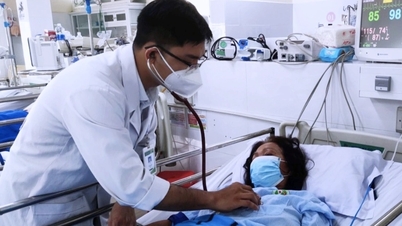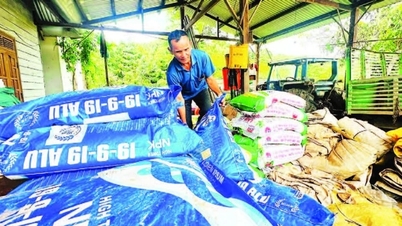High intensity exercise or overtraining in an unstable cardiovascular condition can lead to cardiac arrest and sudden death if not treated promptly.
High intensity exercise or overtraining in an unstable cardiovascular condition can lead to cardiac arrest and sudden death if not treated promptly.
Many studies have shown that strenuous exercise can easily lead to sudden cardiac arrest or sudden cardiac death in people with underlying heart disease. In addition, strenuous exercise also increases the risk of arrhythmia, especially for patients with hypertrophic cardiomyopathy or coronary artery disease.
 |
| Emergency doctors treat a patient with acute myocardial infarction. |
According to Master, Doctor, Specialist II Huynh Thanh Kieu, Head of Cardiology Department 1, Cardiovascular Center, Tam Anh General Hospital, Ho Chi Minh City, a sedentary lifestyle increases the risk of heart disease by 50%.
Regular exercise helps reduce risk factors for stroke and heart attack, including diabetes, dyslipidemia, hypertension, obesity, etc.
In addition, regular exercise also increases good cholesterol (HDL-C), contributing to improving coronary artery endothelial function and limiting atherosclerosis.
The American Heart Association recommends that each person should spend 150 minutes of moderate-intensity exercise, such as brisk walking, cycling, swimming..., or 75 minutes of vigorous-intensity exercise such as jogging, weightlifting, tennis... each week.
However, many people are too eager to lose weight, want to quickly have a toned body or prepare to participate in a sports tournament, so they rush into high-intensity training without advice or guidance from experts. This can cause cardiovascular events including heart attack, arrhythmia, sudden death.
Research shows that sports-related deaths are mainly due to coronary heart disease in adults and cardiomyopathy or arrhythmia in adolescents.
Other heart conditions, such as myocarditis, valvular heart disease, congenital heart disease, or pulmonary hypertension, can also contribute to death during exercise.
According to Associate Professor, Dr. Pham Nguyen Vinh, Director of the Cardiovascular Center, when exercising at high intensity, the heart beats faster and pumps blood more strongly, requiring more oxygen than normal.
In people with coronary artery disease due to atherosclerosis, stress (pressure) on the vessel wall can cause plaque to break off. Plaque floats in the vessel lumen, if it stops in the heart or brain, it will block these blood vessels causing stroke and myocardial infarction.
For people with underlying heart disease (previously undetected cardiovascular disease), overexertion will affect the heart muscle, activating the heart's electrical system at the wrong time and causing sudden cardiac arrest, leading to death on the gym floor.
Additionally, many gym-goers use steroids and performance-enhancing drugs to promote muscle growth. These substances often have side effects on the heart, including high blood pressure, high blood lipids, and heart muscle hypertrophy, all of which increase the risk of heart attack.
Doctor Kieu cited the case of a 20-year-old male patient who was brought to the emergency room in a state of shortness of breath, gasping for breath, and dizziness.
He said he spent most of the last 3 days at the gym because he was about to participate in a district weightlifting competition. This afternoon he increased the intensity of his workout, and after 30 minutes he suddenly fainted.
After examination, the doctor diagnosed him with a genetic condition called hypertrophic cardiomyopathy. Excessive exercise causes an irregular heartbeat, causing the heart's electrical system to lose control.
Fortunately, he received proper first aid and arrived at the hospital in time, so no dangerous complications occurred. Before being discharged, he was advised on appropriate exercise for his physical condition, and instructed to return for check-ups and follow-up to detect any abnormalities early.
“If heart disease is well controlled and exercise is done properly, the risk of cardiovascular complications is very low, only 0.31 – 2.1 times/100,000 people per year,” Associate Professor Vinh affirmed, adding that in people who exercise regularly, this risk is even lower than in people who are sedentary.
The expert also cited the case of swimmer Dana Vollmer, who won an Olympic gold medal and set a world record in 2012 despite having long QT syndrome, a genetic heart condition.
This is a disorder of the heart's electrical activity, leading to an irregular heartbeat and can cause the patient to stop at any time. Thanks to good disease control and a reasonable training regimen, Dana not only plays sports like a normal athlete but also overcomes the disease to win a world gold medal.
Given the above reality, to ensure safety when exercising, it is necessary to note the following issues: Perform a basic cardiovascular test, especially for people over 40 years old and people with a history of heart disease.
The basic cardiovascular check-up package includes an ECG (reading the electrical activity in the heart at rest, helping to diagnose abnormalities in the structure and rhythm of the heart), an exercise test (monitoring the heart's response to physical exertion), an echocardiogram (to evaluate the blood flow, structure and function of the heart), and a family history check (to see if anyone has died from heart disease or had a heart attack).
Consult your doctor about appropriate exercise. If you have a history of heart disease, heart attack, or chronic conditions such as musculoskeletal problems, kidney failure, or diabetes, ask your doctor what type and intensity of exercise is right for you.
When exercising, remember to take 1-2 days off each week to give your body time to recover. Avoid overtraining as this can lead to burnout, injury, and poor performance.
Warm up properly. This helps to warm up your body, prepare your muscles for the main workout, and also stimulates your circulatory system to pump oxygen-rich blood throughout your body.
After your workout, spend 10-15 minutes doing yoga or stretching to speed up recovery and mobility. These exercises help increase range of motion, prevent muscle stiffness, and reduce injury.
Do not exercise when you are too hungry or too full. Exercising when you are hungry can easily cause hypoglycemia, while being too full can cause blood to concentrate on the digestive system. The increased volume of the stomach compresses the diaphragm, limiting the supply of enough oxygen to the heart and brain, leading to fainting.
Listen to your body during exercise. If you experience any unusual symptoms such as chest pain, shortness of breath, dizziness, sweating, etc., stop immediately. If the symptoms do not improve after resting for 15-30 minutes, go to the hospital for a check-up.
Prepare necessary medical equipment. Carrying a blood pressure monitor, heart rate monitor, automated external defibrillator (AED), nitrate tablets, etc. not only helps the practitioner monitor cardiovascular health during the entire exercise period but also increases the chance of survival if an accident occurs.
Along with exercise, each person needs to build a healthy diet, not smoke, limit alcohol, get enough sleep, stay away from stress... to improve overall health. A healthy body does not only come from exercise but is achieved through a combination of many factors.
Source: https://baodautu.vn/canh-giac-voi-nguy-co-dot-tu-khi-tap-the-thao-qua-suc-d228504.html




![[Photo] Binh Trieu 1 Bridge has been completed, raised by 1.1m, and will open to traffic at the end of November.](https://vphoto.vietnam.vn/thumb/1200x675/vietnam/resource/IMAGE/2025/10/2/a6549e2a3b5848a1ba76a1ded6141fae)











![[Video] Ministry of Health issues document to rectify medical examination and treatment work](https://vphoto.vietnam.vn/thumb/402x226/vietnam/resource/IMAGE/2025/10/2/54913f30a9934e18bcbb246c2c85f11d)



















































































Comment (0)